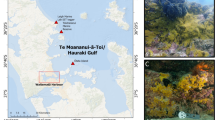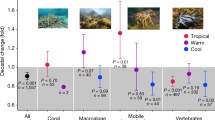Abstract
Purpose of Review
Several small isolated Pacific Ocean atoll lagoons were characterized by their unique abundances of giant clams for at least 35 years, but they were recently affected by massive mortalities. We review evidences that confirm collapses in the past 10 years, discuss the likely causal factors based on current knowledge, and assess the consequences for management.
Recent Findings
Recent in situ and modeling research have focused on how management, natural processes, and climate change can influence the population trajectories. Projections suggest increasing risks with limited management options to reverse the trend.
Summary
The various documented cases support the hypothesis that mass mortalities of giant clams are triggered by climate variability, enhanced by the geomorphological specificities of these atolls. The exact mechanisms leading to mortalities and consequences for the whole ecosystem remain unknown and are probably case-dependent. These collapsing ecosystems represent well the fast impact that climate change can have on reef ecosystems.


Similar content being viewed by others
References
Papers of particular interest, published recently, have been highlighted as: • Of importance •• Of major importance
Hoegh-Guldberg O, Andréfouët S, Fabricius KE, Diaz-Pulido G, Lough JM, Marshall PA, et al. Vulnerability of coral reef ecosystems in the tropical Pacific to climate change. In: Bell JD, Johnson JE, Hobday AJ, editors. Vulnerability of tropical Pacific fisheries and aquaculture to climate change. Noumea: Secretariat of the Pacific Community; 2011.
Hughes TP, Kerry JT, Alvarez-Noriega M, Alvarez-Romero JG, Anderson KD, Baird AH, et al. Global warming and recurrent mass bleaching of corals. Nature. 2017;543:373–7. https://doi.org/10.1038/nature21707.
Neo ML, Eckman W, Vicentuan K, Teo SLM, Todd PA. The ecological significance of giant clams in coral reef ecosystems. Biol Conserv. 2015;181:123.
• Van Wynsberge S, Andréfouët S, Gaertner-Mazouni N, Wabnitz CCC, Gilbert A, Remoissenet G, et al. Drivers of density for the exploited giant clam Tridacna maxima: a meta-analysis. Fish Fish. 2016;17:567–84. This reference reviews the causal factors of T. maxima densities at a global scale and highlight reef type to be an important factor.
Salvat B. Dominant benthic mollusks in closed atolls, French Polynesia. Galaxea J Coral Reef Stud. 2009;11:197–206.
Neo ML, Wabnitz CCC, Braley RD, Heslinga GA, Fauvelot C, Van Wynsberge S, et al. Giant clams (Bivalvia: Tridacninae): a comprehensive update of species and their distribution, current threats and conservation status. Oceanogr Mar Biol Annu Rev. 2017;55:85–388.
Gilbert A, Yan L, Remoissenet G, Andréfouët S, Payri C, Chancerelle Y. Extraordinarily high giant clam density under protection in Tatakoto atoll (Eastern Tuamotu archipelago, French Polynesia). Coral Reefs. 2005;24:495.
Green A, Craig P. Population size and structure of giant clams at Rose atoll, an important refuge in the Samoan Archipelago. Coral Reefs. 1999;18:205–11.
Laurent V, Varney P, editors. Historique des cyclones de Polynésie française de 1831 à 2010. Papeete: Météo-France; 2014.
Salvat B. La faune benthique du lagon de l’atoll de Reao (Tuamotu, Polynésie). Cah Pacifique. 1972;16:30–109.
Gilbert A, Andréfouët S, Yan L, Remoissenet G. The giant clam Tridacna maxima communities of three French Polynesia islands: comparison of their population sizes and structures at the early stages of their exploitation. ICES J Mar Sci. 2006;63:1573–89.
Andréfouët S, Van Wynsberge S, Gaertner-Mazouni N, Menkes C, Gilbert A, Remoissenet G. Climate variability and massive mortalities challenge giant clam conservation and management efforts in French Polynesia atolls. Biol Conserv. 2013;160:190–9.
Andréfouët S, Gilbert A, Yan L, Remoissenet G, Payri C, Chancerelle Y. The remarkable population size of the endangered clam Tridacna maxima assessed in Fangatau atoll (Eastern Tuamotu, French Polynesia) using in situ and remote sensing data. ICES J Mar Sci. 2005;62:1037–48.
ISPF 2012. Données détaillées, www.ispf.pf/bases/Recensements/2012.aspx. Papeete, Consulted 5th July 2017.
Van Wynsberge S, Andréfouët S, Gaertner-Mazouni N, Wabnitz CCC, Menoud M, Le Moullac G, et al. Growth, survival and reproduction of the giant clam Tridacna maxima (Röding 1798, Bivalvia) in two contrasting lagoons in French Polynesia. PLoS One. 2017; https://doi.org/10.1371/journal.pone.0170565.
Menoud M, Van Wynsberge S, Le Moullac M, Peva L, Andréfouët S, Remoissenet G, et al. Identifying robust proxies of gonad maturation for the protandrous hermaphrodite Tridacna maxima (Roding 1798, Bivalvia) from the individual to the population scale. J Shellfish Res. 2016;35:51–61.
Caswell H. Matrix population models, construction, analysis, and interpretation. 2nd ed. Sunderland: Sinauer Associates, Inc. Publishers; 2001. p. 722.
•• Van Wynsberge S, Andréfouët S, Gaertner-Mazouni N, Remoissenet G. Consequences of a uncertain mass mortality regime triggered by climate variability on giant clam population management in the Pacific Ocean. Theor Popul Biol. 2017 (in review). This reference suggests limited management options for the giant clam resource if climate variability increases in the future.
Andréfouët S, Pagès J, Tartinville B. Water renewal time for classification of atoll lagoons in the Tuamotu archipelago (French Polynesia). Coral Reefs. 2001;20:399–408.
Jameson S. Early life history of the giant clams Tridacna crocea Lamarck, Tridacna maxima (Röding) and Hippopus hippopus (Linnaeus). Pac Sci. 1976;30:219–33.
•• Andréfouët S, Dutheil C, Menkes C, Bador M, Lengaigne M. Mass mortality events in atoll lagoons: environmental control and increased future vulnerability. Glob Chang Biol. 2015;21:195–205. This reference highlights that low wind, low swell, and high temperature are correlated with mass mortality events, and predicts higher risk of mortality in the future.
Lowe RJ, Falter JL. Oceanic forcing of coral reefs. Annu Rev Mar Sci. 2015;7:43–66.
Dumas F, Le Gendre R, Thomas Y, Andréfouët S. Tidal flushing and wind driven circulation of Ahe atoll lagoon (Tuamotu Archipelago, French Polynesia) from in situ observations and numerical modelling. Mar Pollut Bull. 2012;65:425–40.
Adjeroud M, Andréfouët S, Payri C. Mass mortality of microbenthic communities in the lagoon of Hikueru atoll (French Polynesia). Coral Reefs. 2001;19:287–91.
•• Andréfouët S, Van Wynsberge S, Kabbadj L, Wabnitz CCC, Menkes C, Tamata T, et al. Adaptive management for the sustainable exploitation of lagoon resources in remote islands: lessons from a massive El Niño-induced giant clam bleaching event in the Tuamotu atolls (French Polynesia). Environ Conserv. 2017; https://doi.org/10.1017/S0376892917000212. This reference documents a 2016 bleaching event of giant clams and discuss the consequences for resource management and aquaculture.
Chancerelle Y. Le phénomène de blanchissement corallien sur la zone Pacifique central sud en 2016. Bilan des observations. Moorea: Report IFRECOR; 2017.
Van Wynsberge S, Menkes C, Le Gendre R, Passfield T, Andréfouët S. Are satellite measurements of oceanic SST reliable proxies of lagoon temperature in the South Pacific? Estuar Coast Shelf Sci. 2017;199:117–24.
Addessi L. Giant clam bleaching in the lagoon of Takapoto atoll (French Polynesia). Coral Reefs. 2001;19:220.
Altieri AH, Harrison SB, Seemann J, Collin R, Diaz RJ, Knowlton N. Tropical dead zones and mass mortalities on coral reefs. PNAS. 2017;114(14):3660–5.
Donner S. Coping with commitment: projected thermal stress on coral reefs under different future scenarios. PLoS One. 2009;4:e5712.
Jones AM, Berkelmans R, Van Oppen MJH, Mieog JC, Sinclair W. A community change in the algal endosymbionts of a scleractinian coral following a natural bleaching event: field evidence of acclimatization. Proc R Soc B. 2008;275:1359–65. https://doi.org/10.1098/rspb.2008.0069.
Guest JR, Baird AH, Maynard JA, Muttaqin E, Edwards AJ, Campbell SJ, et al. Contrasting patterns of coral bleaching susceptibility in 2010 suggest an adaptive response to thermal stress. PLoS One. 2012;7:e33353. https://doi.org/10.1371/journal.pone.0033353.
Hughes TP, Graham NAJ, Jackson JBC, Mumby PJ, Steneck RS. Rising to the challenge of sustaining coral reef resilience. Trends Ecol Evol. 2010;25:619–80.
Adjeroud M, Andréfouët S, Payri C, Orempuller J. Physical factors of differentiation in macrobenthic communities between atoll lagoons in the central Tuamotu Archipelago (French Polynesia). Mar Ecol Prog Ser. 2000;196:25–38.
Mellin C, Ferraris J, Galzin R, Kulbicki M, Ponton D. Diversity of coral reef fish assemblages: Modelling of the species richness spectra from multi-scale environmental variables in the Tuamotu Archipelago (French Polynesia). Ecol Model. 2006;198:409–125.
Pagano M, Sagarra P-B, Champalbert G, Bouvy M, Dupuy C, Thomas Y, et al. Metazooplankton communities in the Ahe atoll lagoon (Tuamotu Archipelago, French Polynesia): spatiotemporal variations and trophic relationships. Mar Pollut Bull. 2012;65:538–48.
Mou-Tham G, Kulbicki M, Gilbert A, Tuahine J, Andréfouët S. Assembly rules of fish communities in Tuamotu Archipelago atoll lagoons: the case of Fangatau, a lagoon dominated by giant clam habitats. Mar Biodivers. 2017; https://doi.org/10.1017/s12526-017-0708-1.
Gilbert A, Andréfouët S, Gascuel D. Dynamique des populations, modélisation halieutique, approche de précaution et stratégie de co-gestion adaptative des pêcheries de bénitiers de trois îles de Polynésie française. Report Arue, Tahiti: Institut de Recherche pour le Développement; 2007.
Van Wynsberge S, Andréfouët S, Gilbert A, Stein A, Remoissenet G. Best management strategies for sustainable giant clam fishery in French Polynesia islands: answers from a spatial modeling approach. PLoS One. 2013;8:e64641. https://doi.org/10.1371/journal.pone.0064641.
Van Wynsberge S, Andréfouët S, Gaertner-Mazouni N, Remoissenet G. Conservation and resource management in small tropical islands: trade-offs between planning unit size, data redundancy and data loss. Ocean Coast Manag. 2015;116:37–43.
Acknowledgements
The authors state that there is no conflict of interest. Most of the studies cited in this review would not have been possible without the consent and logistical help of inhabitants of Tuamotu atolls and village authorities. The Direction des Resources Marines et Minières supported the research activities through various grants since 2002. We acknowledge the participation and involvement of many colleagues throughout the years, most of them co-authors of the papers reviewed here. Two anonymous reviewers and the Section Editor (Chris Langdon) made useful suggestions to improve the initial draft. This is Entropie contribution # 235.
Author information
Authors and Affiliations
Corresponding author
Additional information
This article is part of the Topical Collection on Corals and Climate Change
Rights and permissions
About this article
Cite this article
Van Wynsberge, S., Andréfouët, S. The Future of Giant Clam-Dominated Lagoon Ecosystems Facing Climate Change. Curr Clim Change Rep 3, 261–270 (2017). https://doi.org/10.1007/s40641-017-0078-6
Published:
Issue Date:
DOI: https://doi.org/10.1007/s40641-017-0078-6




